Presented at the Lenten Retreat of East American Diocese of the Russian Church Abroad, in Mayfiled, PA, 2010
Vasily Maximenko was born on August 8th, 1873 in the village of Glafirovka, on the shore of the Sea of Azov, near Yeysk, in the family of Deacon Ioann Vasilievich Maximenko. The conditions of the boy’s upbringing were severe.[1] Details of the early period of his life were taken from “What I remember about myself,” Motivy moey zhizni. (Jordanville: Printshop of St. Job of Pochaev, second edition, no year ind.). Of all the children in his family, only seven survived. “I remember, at the baptism of my younger brother Spyridon,” recalled Archbishop Vitaly, “at 4-5 years of age I was offered vodka. It was bitter and I cringed, but I nonetheless dipped my bread [in the vodka] and ate it, while my father kept saying,
‘What, is it bitter? No matter. Eat up! That way you won’t be a drunk when you grow up.’”[2] Idem. p. 169. The salary the family received from the parish was insufficient, and Vasily’s father had to take up “the apostles’ trade:” fishing. It was from this that he would contract pleurisy and die prematurely at age 42. “He was only buried in the spring, and I had to stand at his coffin with a blossoming cherry branch to ward off the flies,” writes Vladyka. “A year later our mother died of grief and we were left total orphans in the hands of our older sister Masha, who was 18 years old”.[3] Idem. p. 170.
Vladyka studied at the Theological School in Mariupol, on the shore of the Sea of Azov. Here I was at first all alone: the other lads went home for Nativity, Pascha, summer vacations, and I strolled by myself around the spacious school grounds… But I have good memories of this time… In school, the wealthier boys had sugar and drank tea, while we, proletarians, would take our bread and a handful of salt and go out to a place where there grew a patch of bitter greens. We called it salad-cress. Eaten with these greens, the bread was very tasty.[4] Idem. pp. 170-171. Vasily worked hard, and for graduating to the second year, he was given an award in books: One Thousand and One Nights and the works of Darwin.
Upon completion of the Theological School, Vasily was accepted into the seminary in Yekaterinoslav (today Dnepropetrovsk in the Ukraine). Upon successful completion of seminary, he was accepted into the Kiev Theological Academy. Recalling academic traditions there, Vladyka said, “At the beginning of the school year, the senior class would deliver lecture notes to the freshman class, and in accordance with established tradition would hold a sort of ‘cocktail hour,’ participants of which would also include the guardians of order, the academy supervisors.”[5] Idem. p. 171. The student body nurtured a defiant attitude toward the administration. In Vasily’s second year at the academy, another student suggested staging a protest against the dean, the famous theologian-dogmatist Bishop
Silverster (Malevansky, reposed 1908), and skipping the Rite of Forgiveness that he was to lead. Others recommended not offending the elder and instead protesting the academy steward, maintaining that he was appropriating foodstuffs set aside for the students’ meals. A majority of the students sat out dinner. The administration demanded a written explanation from the “strikers.” And here the character of the future Archbishop Vitaly shone through: he refused to lie and write that his aunt had come to visit him and he had to meet up with her. As a result, he was expelled from the academy with a “wolf’s passport,” that is, he lost the right to apply to other academic institutions.
Vasily was unable even to get a job teaching in the city’s parochial schools, and had to depart for Yekaterinoslav’s countryside to teach at a public school. The school would open up a series of labors and projects, starting from nothing, that would continue through the life of the future Archbishop Vitaly. “I made the schoolhouse habitable; I installed glass panes in the windows, gathered firewood and worked with the children from morning to evening. The locals were so pleased that they began feeding me pies and all sorts of goodies. At the examinations my school, which for several years had not had any graduates and was considered the worst, came out on top.”[6] Idem. p. 173. It was at this time that the president of the Kazan Theological Academy, Bishop Anthony (Khrapovitsky) of Cheboksary, took notice of Vasily. Vladyka Anthony would continue looking after him until the end of his days. Vasily was accepted to the second course year at the Academy due to the intercessions of Bishop Anthony.
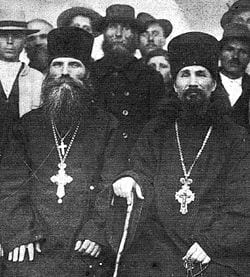
With the confessor of Orthodoxy and Archimandrite Aleksei (Kaboliuk) glorified by UOC
Vladyka Anthony, who from childhood had dreamed of monasticism, was a capable man, and ignited in others love toward an angelic lifestyle. Under his influence, over the course of Great Lent in 1899, Vasily decided his fate. Being that tuberculosis had already begun to afflict him, Bishop Anthony gave him the name Vitaly in tonsure, which translated from the Latin means “full of life.”[7] N.D. Talberg, “Zhiznennyi put’ Arkhiepiskopa Vitaliia.” Pravoslavnaya Rus’ (Orthodox Russia), 3 (February 1959): 4. Soon after this he was ordained a hieromonk and assigned to the Donskoy Monastery in Moscow, after which he was sent to St. Alexander Missionary Seminary, near Vladikavkaz. The climate there greatly benefited his health. Here Fr. Vitaly visited lepers and attempted to save a seminarian who had accidentally spilled a lit kerosene lamp on himself. Fr. Vitaly himself received serious burns.[8] Archbishop Anthony (Medvedev), “Prisnopamiantyi Arkhiepiskop Vitalii, Vostochno-Amerikanskiii Dzhersitskii: K 25-ti letiiu Ego konchiny.” Pravoslvanaia Rus’, 6 (1985): 9-10. This preparedness to sacrifice himself was a chief trait of Archbishop Vitaly’s character. In the beginning of 1903, Fr. Vitaly was elevated to the rank of archimandrite and assigned to preach in Pochaev Lavra, at the insistence of the newly installed Archbishop of Volhynia, Anthony (Khrapovitsky).
Here in Pochaev, Fr. Vitaly performed his second labor: the restoration of Pochaev’s printshop. In his memoirs,[9] “Arkhiepiskop Vitalii: k stoletiu so dnia rozhdeniia. Tserkovnaia zhizn’ 5-7 (1973): 55-71. Archbishop Nikon (Rklitsky) wrote that when Fr. Vitaly arrived in Pochaev, the printshop was in neglect, and no one was working it. Shortly, a three-story building was erected with space for eight printing presses, and the brotherhood of the printshop grew to 120-150 men. Archbishop Anthony testified of Fr. Vitaly’s work: “he so loved the [printing] work, that he gathered an entire army of novices and in recent years, parallel to the brethren of the Lavra, built a dormitory for them. He had monks and novices, but he also hired laborers, and paid them out of his own salary. He slept little, and often right in the printshop, somewhere under a printing press, while he let the workers stay in his archimandrite’s cell.”[10] N.D. Talberg, “Zhiznennyi put’ arkhiepiskopa Vitaliia.” p. 5.
Fr. Vitaly lived “in a small room with no furniture; last year [1908] he walked about 900 versts [approx. 600 miles] on foot delivering sermons, and at home in the Lavra he constantly led discussions with visiting peasants, or would spend time writing articles for Listok, the monastery newsletter; he was thin, almost consumptive, never laughing, but often crying.”[11]From the response of Archbishop Anthony (Khrapovitsky) to N.A. Berdyaev’s article in Moskovskii Ezhenedel’nik in 1909. Citation from Protopresbyter Michael Pomazansky’s “Arkhiepiskop Vitalii … Continue reading
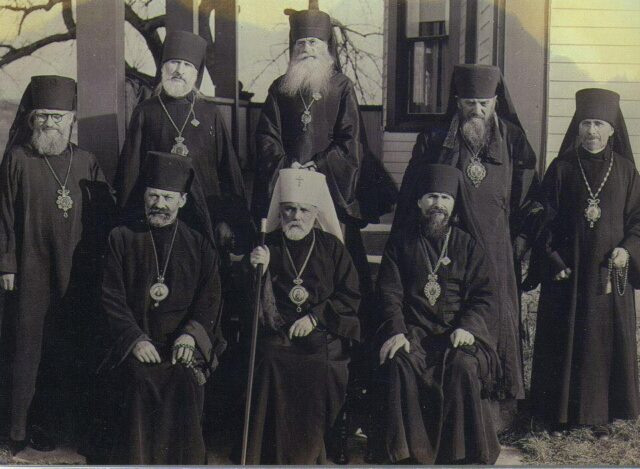
Standing: Bishop Makary (Mikhail Ilyinsky, 1886-1953) of Boston, Vicar of Met. Theophilus, Bishop Leonty (Turkevich, 1876-1965) of Chicago, Bishop Ieronim (Chernov, 1878-1957) of Detroit & Cleveland, Bishop Arseny (Chagovtsev, 1866-1945) of Winnipeg & Canada, Bishop Benjamin (Basalyga, 1887-1963) of Pittsburgh & West Virginia. seated, L-R: Bishop Adam (Phillipovsky, 1881-1956) no title at that time, Theophilus (Pashkovsky, 1874-1950), Archbishop of San Francisco, Metropolitan of All America & Canada, Archibishop (?) Vitaly (Maximenko, 1873-1960) not sure of his title then
During one of these processions in 1908, near the settlement of Berestechko, the peasants brought to Fr. Vitaly’s attention a field, strewn with bones belonging to Hetman Bogdan Khmelnitsky’s Cossacks, who fell in 1651 in an uneven battle with the Poles. During the battle, the Cossacks were encouraged by an envoy of the Patriarch of Constantinople, Bishop Joasaph, who was himself captured and shot. Fr. Vitaly was greatly affected by the words of one Dane, a landlord of Count Grabbe’s: “You are an unenlightened and ungrateful people. If something akin to this occurred in our Denmark, if our grandfathers had so heroically fallen for our homeland and faith, we would long ago have gilded the place of their death, would long ago have erected a monument to them worthy of so great a feat. Each of us, even the lowliest schoolboy, would know where this place was and what transpired hereupon.”[12] Archbishop Nikon, “Arkhiepiskop Vitalii.” p. 60.
On the spot of the “Cossack graves,” a monastery skete was built. The bones of the Cossacks were gathered in the lower church and covered in glass. Emperor Nicholas II donated 25,000 rubles to the project. [13] Idem. p. 61.
Having truly dedicated his whole life to his flock, Vladyka Vitaly cared not only for their souls, but also for their bodies. He participated in the founding of the Pochaev People’s Bank, which gave credit to the peasants. [14]After the 1917 Revolution, Fr. Vitaly was captured by the Bolsheviks in Pochaev. The commissar condemned him to be shot. “So, Petro,” Fr. Vitaly quietly addressed the commissar, “You want to … Continue reading From August 1906, Fr. Vitaly led the Pochaev’s Union of the Russian People. [15] V.I. Kosik, “Vitaliy (Maximenko),” Pravoslavnaya Entsiklopedia 8 (Moscow: Orthodox Encyclopedia, 2001), 562. In an effort to unite the peasantry, the Pochaev printshop published leaflets with a message similar in nature to the below appeal to the clergy of the Volhynia Diocese, signed by Archimandrite Vitaly: “The Lord God Himself has placed in your care not only the souls of your flock, but everything that affects their material well-bring (…) Explain to your parishioners the great benefit of your national Russian shop, where they can obtain at any time much-needed products, all of high quality and affordable, with no fallacious measurement or weighing, or any other Jewish trickery. [16] Pochaevskii listok 23 (June 18, 1910).
During the revolutionary events of 1906, Fr. Vitaly denounced the revolutionaries and prevented the people from rising up. V.V. Shulgin, a member of the Fourth State Duma, testified that there was not “one Jewish pogrom on the conscience of Archimandrite Vitaly, despite his fiery speeches calling the people to fight the revolution (…), and in general, there was no violence to speak of.” [17] Dni. Citation from N.D. Talberg, “Zhiznennyi put’ arkhiepiskopa Vitaliia.” p. 6. In 1907 Fr. Vitaly bought 75 train cars full of bread for starving Volhynia, and in the following 1908 year he cooperating in helping resettle members of the Union of the Russian People to the fertile lands of the Baikal and Amur regions. [18] Archbishop Anthony (Khrapovitsky), citation from Protopresbyter Michael Pomazansky, “Arkhiepiskop Vitalii.” p. 5.
Toward the end of the First World War, Fr. Vitaly was appointed as a spiritual father for troops in combat, and selflessly traveled the trenches, inspiring the soldiers. On one of these trips he fell ill and lay unconscious for several weeks. Having found out about the emperor’s abdication, Archimandrite Vitaly traveled to the Tsar’s military headquarters in Mogilev in order to plead with the sovereign to rescind his abdication. He was not allowed a meeting. [19] Archbishop Nikon, “Akhiepiskop Vitalii.” p. 62.
In January 1918, he co-served in Kiev with the New Hieromartyr Vladimir several days before the latter’s martyrdom.[20] Archbishop Anthony, “Prisnopamiatnyi Arkhiepiskop Vitalii.” p. 10. In May of the same year, he participated in a secret monarchist conference in Kiev.[21] N.D.Talberg, “Zhiznennyi put’ arkhiepiskopa Vitaliia.” p. 6.
In March of 1919, Archimandrite Vitaly was arrested by representatives of Petliura’s Directory and imprisoned in the Uniate Basilian monastery in Buchach. Archbishop Eulogius of Volhynia, imprisoned alongside him, recalled how relations with the monks would have developed splendidly, “had it not been for Archbishop Vitaly’s animus toward Catholicism. He would instigate arguments with the monks, attacking them, calling them heretics and apostates… and somehow once in a moment of fierce temper he announced, ‘Your Communion is the food of demons.’”[22] Put’ moei zhizni: Vospominaniia metropolita Evlogiia (Georgievskogo) izlozhennkogo po ego rasskazam T. Manukhinoi (Moscow Worker: Moscow, 1994), 298.
Freed several months later, Fr. Vitaly was once again arrested, this time by the Polish government, who charged him with having dealings with the partisans. Interestingly, Fr. Vitaly, describing his imprisonment in the underwater casemate of Ivangorod (in Demblin), almost as if he weren’t even talking about himself, mentioned apropos, “Not anticipating such an answer, the officer there and then, in front of the Catholic priests, beat me unmercifully and ordered the sergeant to return me to the casemate. On the way, the sergeant too followed the officer’s example.”[23] “Demblin,” Motivy moei zhizni. p. 184. Thanks to the help of a Russian nurse, representatives of the French government were made aware of Fr. Vitaly’s situation and assisted in his release.[24] N.D. Talberg, “Zhiznennyi put’ arkhiepiskopa Vitaliia.” p. 6. At the invitation of Metropolitan Anthony, Fr. Vitaly traveled to Yugoslavia. However, since there was no opportunity in Serbia to develop printing work, in 1921 Fr. Vitaly left for Slovakia, to the town of Svidnik. “I live,” he wrote, “in the most out-of-the- way gorge in the Russian land, where outside influences cannot penetrate, where the surroundings and lifestyle are virtually those of the 17th Century.”[25] “Rech’ pri narechenii vo episkopa,” Motivy moei zhizni . p. 9. The territory was within the jurisdiction of the Serbian Orthodox Church, although Fr. Vitaly, to the bewilderment of the local Serbian bishop Damaskin, ignored this fact and subordinated the monastery he founded to the Synod of Bishops of ROCOR.[26] S. Ryasnyansky, “K stoletiiu” “The first years of Archimandrite Vitaly were very difficult. it was recommended of him that he don a ‘reverend’ (the white clerical collar) and ‘get naked’ (that is, shave his beard). He refused to do either. There was neither church nor means. In order that services might be performed, a tavern was purchased. The ‘Gazdinas’ – landladies – took turns feeding him, like a village shepherd.”[27] N.D. Talberg , “Zhiznennyi put’ arkhiepiskopa Vitaliia.” p. 7. Fr. Vitaly shared a room with his missionary brethren, and they all slept together on straw. Divine services were served on the second floor, while the Uniates demonstrated below. From Svidnik, Fr. Vitaly would go on foot every day to Ladomirova, where he would serve liturgies and perform various religious rites for the people. The people would pay him in groceries, which he would then have to carry five kilometers back to his brethren.[28] [Archimandrite Seraphim (Ivanov)] “Otets- Vladyka: K pribytiiu v obitel’ prep. Iova stroitelia ee, Arkhiepiskopa Vitaliia,” Pravoslavnaia Rus’ 15 (1935): 1. Forty years later, he would similarly carry vegetables from Jordanville in his suitcase on the New York subway to his diocesan brethren.
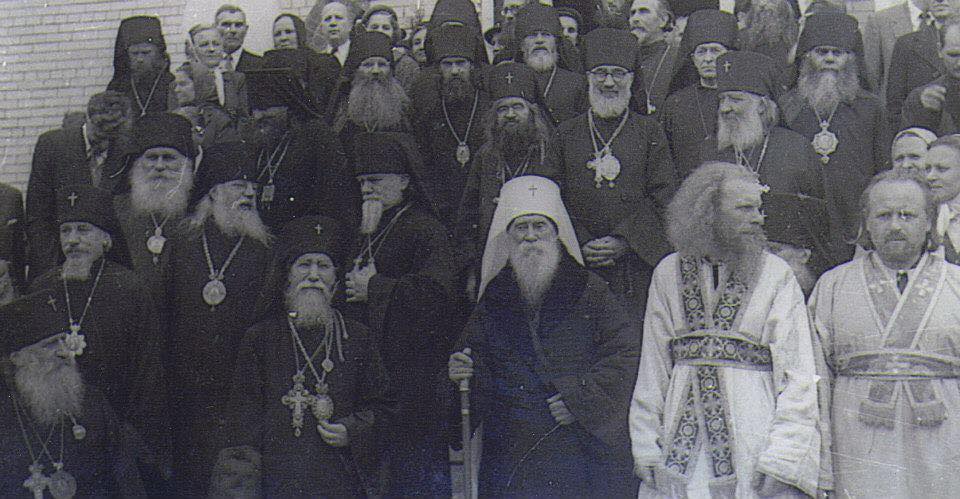
Participants of 1953 Bishop Council visiting Holy Trinity Monastery in Jordanville, NY
Archimandrite Seraphim (Ivanov) shared his memories of the labors of Fr. Vitaly in Ladomirova with us: “He participated in building projects of the monastery on par with the brethren. He transported no less than a thousand wheelbarrows of dirt alone. He participated in kitchen work, as well.
And he did it all quietly, humbly, matter-of-factly, without a shadow of ostentatiousness. Once he spent a whole winter cleaning the communal cesspool by hand, once a week, at night, keeping the unsuspecting brethren ignorant of his activities. When this was accidentally found out, he humbly replied to the outcry: ‘It is difficult for me to assign this obedience. Since there are no volunteers, it’s easier to do it myself.’.”[29] Ibid.
Here, in Vladimirovo in 1928, Fr. Vitaly baptized Vasily Skurla, later our ever-memorable first hierarch.
In 1925, the Tserkvonyi Russkii Kalendar’ was published. In 1928, the newspaper Pravoslavnaya Karpatskaya Rus’, the goal of which was to defend the Orthodox minority from Uniate assaults, began circulation. The brotherhood achieved full financial independence. “At first it was difficult,” wrote Fr. Vitaly to Dimitry Shakhovsky in 1926, “but the first steps have been taken. Our labors have borne certain fruits – savings, and a reserve of publications. We sell those publications, we make some money, and then we can print more and better…”[30] Archbishop John (Shakhovsky), Biografiia Iunosti (Paris:YMCA-Press, 1977), 378. Archpriest Alexander Tzuglevich was sent to America to collect funds for the construction of a church in Vladimirovo from the Carpatho- Russians who had gone there to work.[31] Archbishop Ambrose, “Pamiati Arkhiepiskopa Vitaliia,” Pravoslavnaia Rus’ 15 (August 1973): 12.
On June 19, 1933, Archbishop Apollinary (Koshevoy), administrator of ROCOR parishes in the United States, reposed, and Archimandrite Vitaly was again offered the opportunity to serve the Church in capacity of hierarch. This time, Metropolitan Anthony put the question firmly to Archimandrite Vitaly: should Archimandrite Vitaly refuse consecration, the Metropolitan would refuse to be his spiritual father. After a few sleepless nights, Archimandrite Vitaly responded in the affirmative to his Abba by means of a single postcard.[32] Archbishop Anthony, “Prisnopominaemyi Arkhiepiskop Vitalii.” p. 10.
At this time, the ROCOR hierarchy began to reevaluate its attitude toward various currents in emigre church life. The 1926 sanction against Metropolitans Eulogius and Platon, who separated themselves from the ROCOR Synod of Bishops, did not lead to reconciliation within the Russian church diaspora. In 1934, Metropolitan Platon reposed. Several days after his death, Archimandrite Vitaly arrived in Belgrade for his consecration. Being present during the private (cell) prayers of Metropolitan Anthony, it made an indelible impression on Fr. Vitaly to see that the former was praying for someone who reposed while under sanction by the Church: “Remember in blessed memory, O Lord, the newly reposed Metropolitan Platon…”[33] Archbishop Vitaly, “Fakty dlia ustanovleniia mira vsei Russkoi Pravoslavnoi Zarubezhnoi Tserkvi,” Motivy moey zhizni. pp. 13-14. That same year, the sanctions against Metropolitan Platon were lifted.[34] Archbishop Anthony, “Prisnopominaemyi Arkhiepiskop Vitalii.” p. 10. It is worth noting that Metropolitan Eulogius of Western Europe arrived in Belgrade at the same time as Archimandrite Vitaly, to discuss reconciliation. On May 6th Archimandrite Vitaly’s consecration was performed. In his word before committing Bishop Vitaly his archpastoral staff, Metropolitan Anthony noted: “Can one teach you [emphasis mine – AP] how to defend yourself against those sins peculiar to your accepted calling, that is, against pride, vanity, and luxury? You are a stranger to them, as your soul is filled with all-forgiveness and meekness. You proved this, when you were strewn with mockery and banishment by fanatics and even subjected to the blows of profane heretics. You accepted persecution from those who were not worthy of your left hand.[35] Archpriest Nicholas Deputatov, “Na smert’ vysokopreosviashchenneishego Vitaliia , Arkhiepeiskopa Vostocho-Amerikanskogo i Dzersisitskogo” Pravoslavnaia Rus’ 13 (July 1960): 7.
On October 15, 1934, Bishop Vitaly arrived in New York, and by December 27 of that year our diocese received legal person (i.e. corporate) status.[36] “Pervaia moia poezdka v Ameriku, 1934-3 5,” Motivy Moey zhizni. p. 158. In 1935, Archbishop Vitaly participated in the conference of bishops in Belgrade, in which Metropolitan Eulogius of Western Europe and Metropolitan Theophilus of the Russian Orthodox Church in the United States and Canada also took part. It was at this conference that restoration of full church relations in the Russian church diaspora was achieved. When Vladyka Vitaly, before his departure for America, asked for guidance from Metropolitan Anthony, the latter replied: “Tell them that we seek not dominion, but church unity; they may continue with their internal order – we are not interested in invading their affairs. But when they will turn to us on any matter, we are ready to offer them assistance.”[37] Archbishop Vitaly, “Pamiati Mitropolita Feofila: dopolnenie k poslaniiu,” Motivy moey zhizni. p. 123.
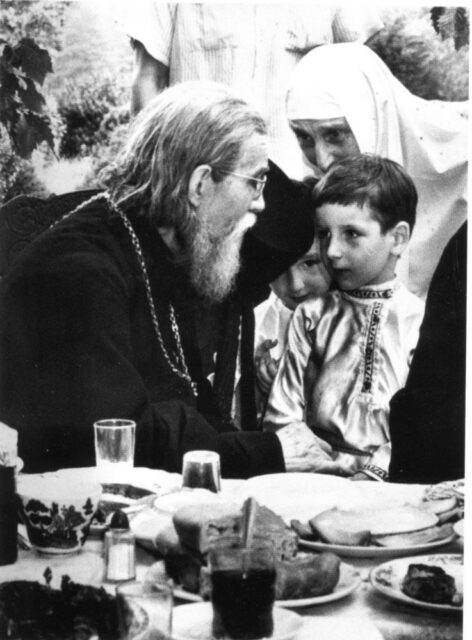
Dmitrii Shatiloff and his brother Egor, watching, with their maternal grandmother Maria A. Shatiloff (nee Tolstoy). Photo taken at one of St. Vladimir’s celebrations in Jackson, NJ
Having arrived in America, Vladyka undertook efforts to establish church unity with the same energy with which he had approached all of his prior obediences, thereby becoming a faithful aide to Metropolitan Theophilus for as long as the latter was in communion with the Council of Bishops of the Russian Church Abroad. For instance, in the beginning of the 1940’s, Archbishop Vitaly participated in the life of St. Vladimir’s Theological Seminary, substituting for Metropolitan Theophilus in his post as president,[38]OCA Archives. XI-Records relating to Church institutions. “U,” St.Vladimir’s Orthodox Theological Seminary. 1. Correspondence and reports. Special thanks to Archivist Alexis Liberovsky for … Continue reading presiding over the joint meeting of the Faculty Council and the Academic Commission.[39] Meeting Journal of the Faculty Council of St. Vladimir Orthodox Theological Seminary, January 16, 1946. Holy Trinity Seminary’s Archives. N. Talberg Collection. R.P.Ts.Z. Box 13 Folder 7.
Among the flock of Metropolitan Theophilus was a significant number of people who had grown up in the United States, who considered it their homeland and sought no connection to their historical fatherland. Supporters of this course were for the creation of an independent local Orthodox Church that would use the English language and the new-style Church calendar. Parishioners of the Russian Church Abroad, on the other hand, were people forced to flee the borders of the former Russian Empire and desirous of returning to their homeland as soon as political circumstances allowed. They preserved the Russian language and culture, and idealized bygone Russia. This course, which Archbishop Vitaly defended, was vibrantly expressed in his construction of St. Vladimir Memorial Church in 1938, the 950th anniversary of the Baptism of Russia. In his spiritual will, Vladyka writes: “Vladimir’s Mount, where we yearly gather… from now on is and for all following times unalterably remains, the guiding beacon – the leading banner in the historic march of the chosen Russian people now in dispersion the world over. Without this “beacon-banner,” the chosen Russian people inevitably will scatter and be assimilated with the other peoples into “one universal people without their national identity,” as this once already was in ancient times before the building of the Babylonian Tower, when all peoples were held together by earthly goods.[40] “Moe dukhovnoe zaveshchanie: 24 iulia/ 6 avgusta 1956,” Pravoslavnaya Rus’ 6 (March 1960): 8.
Archbishop Vitaly, just as Metropolitan Anthony, was an irreconcilable anti-communist. In the interwar period he supported the underground organization, Brotherhood of Russian Truth,[41] “Khristos voskrese!,” Motivy moey zhizni. p. 8. and in 1941 he appealed to President Roosevelt with a request not to open a “Second Front” to help the USSR. “Russians will not willingly fight for Stalin even in the event that we send them our best military experts and give them our superior American weaponry,” readers the appeal.[42] “Protiv diktatury bezbozhnikov v Rossii krasnoi,” Motivy moey zhizni. p. 162.
It is safe to assume that this letter played a significant role in the change in attitude toward the Russian Church Abroad, as a result of the defeat of Nazism by the Soviet Union, America’s ally. A significant portion of the emigration welcomed the changes in the attitude toward religion in the USSR. The Council of Bishops of the North American Diocese (“The Metropolia”) established the commemoration in every church of Metropolitan Sergius (Stragorodsky), elected Patriarch in 1943.[43] Russkaia Pravoslavnaia Tserkov’ v Severnoi Amerike: Istoricheskaia spravka (Jordanville, NY: 1955), 95. It is worth noting that Archbishop Vitaly, in his writings, also calls him by that title. These new circumstances inspired hope amongst influential persons in the North American Church that the Moscow Patriarchate would lift the sanctions placed on its hierarchs in 1935 and the Metropolia would, de facto, be granted autocephaly.
Inasmuch as the Russian Church Abroad did not recognize as canonically legitimate the elections of Patriarchs Sergius and Alexey, while the Moscow Patriarchate imposed sanctions suspending all of the ROCOR hierarchs in 1935, the Metropolia adopted a resolution at its Seventh All-American Council (November 26-29, 1946) to quit its administrative subordination to the Russian Church Abroad. Archbishops Tikhon, Vitaly, and Bishops Joasaph and Jerome rejected the resolution as illegitimate. On March 4, 1947, they were accepted into ROCOR’s Council of Bishops. On March 28, the above-mentioned hierarchs were ejected from the North American Metropolitan District.[44] Idem. p. 136. On May 27-28, 1947, a gathering of hierarchs in Holy Trinity Monastery in Jordanville adopted a resolution calling for the restoration of the “Catholic Orthodox Russian Church.”[45] Idem. p. 137. It is worth noting that Archbishop Vitaly did not want to quit the North American Metropolitan District, believing it would be better to establish an internal opposition with it, on the order of the Anglican Communion, where there is a “High” Church and a “Broad” Church.[46]Archbishop Vitaly, Letter (December 16, 1946, OCA Archives, Series IV – Records of the All-American Councils, 6S Pre 7S, 4:79). Citation from: Nikolaj L Kostur, The Relationship Between the … Continue reading In a letter to his kyriarch, Archbishop Tikhon, he writes, “To take upon ourselves the initiative of division
is unwise: let that remain on their conscience.”[47] Holy Trinity Seminary’s Archives. N. Talberg Collection. R.P.Ts.Z. Box 13 Folder 7. In a letter to Bishop Makary (Ilyinsky), who in 1946 joined the Moscow Patriarchate, Archbishop Vitaly wrote: “I received your letter marked January 26. Let us allow each to act according to his conscience before God? We have but little time left on this earth. We all love our Orthodox Russian Church and would not want to be without her. But in my opinion it is better to try to be faithful, alongside Sts. Vladimir, Anthony, Sergius, Seraphim, and other God-pleasers, with the confessors who even in our time suffered and gave their lives for the Faith, than alongside the officialdom, who could not be representatives of the Church and could fall away from the path of the Church, as it was many times in history. God grant that the contemporary official leaders be true representatives of God, and I would be happy to be convinced of it (emphasis mine – AP), but for the time being their dealings and their behavior do not allow it.
You and I have lived in love and accord. Let us thusly remain. I will pray, and have always prayed, for your health and salvation. If you can, I ask of you the same. God grant us to meet once more in the age to come.”[48] Letter dated April 17, 1947. Idem. Folder 6.
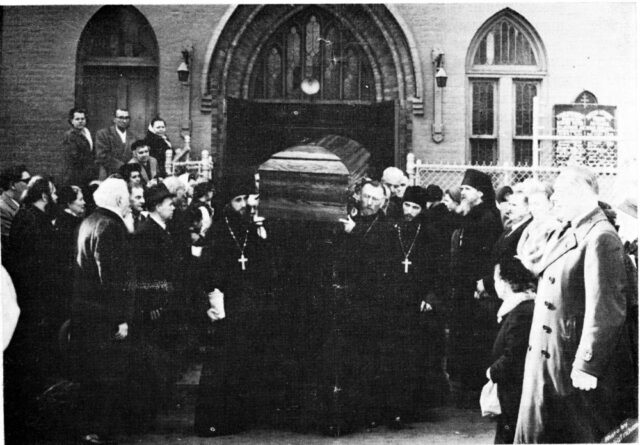
The funeral of Archbishop Vitaly at the cathedral in Bronx. Abbot Laurus is on the right and Abbot Anthony Grabbe is on the left from the viewer.
This historical context gives us an understanding of the following comment by Vladyka in his article, “The Tenets of Christ’s Church:” “The Patriarchate violated the fundamental tenet of Christ’s Church, rejected her fundamental purpose: to serve the revival of the people, replacing it with something unnatural for the Church: servitude to the godless goals of Communism. This departure is bitterer than any previous Arianism, Nestorianism, Iconoclasm, et al.”[49] Clearly the article is written after the separation of the North American Diocese, Motivy moey zhizni. p. 25. In the article, Archbishop Vitaly classifies the Moscow Patriarchate as an apostatized entity. Nevertheless, in the same breath and on the same page he calls her the “Mother Church:” “We have no need to summon a new Ecumenical Council to resolve our dispute with the current hierarchy of our Mother Church (emphasis mine – A.P.).”
In 1946, thanks to the efforts of Archbishop Vitaly, the brethren of St. Job Monastery in Ladomirova traveled to the United States, fortifying Holy Trinity Monastery and expanding print work there. The Synod of Bishops in Geneva owed its existence to the donations sent in by Vladyka. It was he who addressed a session of the United States Congress, explaining to the congressmen who the Russian DPs and Ladomirova monks were.[50] Gleb Benzeman, “Bogatyr’ Dukha,” Pravoslavnaia Rus’ 15 (August 1973): 15-16.
In 1948, Archbishop Vitaly became the first abbot of Holy Trinity Monastery elected by the brethren. On October 13 of that year, the Synod of Bishops in Munich confirmed the opening of Holy Trinity Seminary. “Holy Trinity Theological Seminary,” wrote then-Bishop Laurus in his recollections of Vladyka, “owes its existence entirely to Vladyka Archbishop Vitaly. He was the first to recognize the importance of educating pastors in a strict monastic setting.”[51] Bishop Laurus, “Arkhiepiskop Vitalii (Maksimenko),” Pravoslavnaia Rus’ 6 (March 1970): 4.
Archbishop Vitaly was also concerned with opening a convent, and entrusted its establishment in the capacity of builder and spiritual father to Fr. Adrian Rymarenko. The name “Novo-Diveevo” was given by Bishop Seraphim (Ivanov).[52] Archbishop Nikon, “Arkhiepiskop Vitalii.” p. 70
Other Orthodox Churches maintained relations with Archbishop Vitaly. In 1936, he participated in the hierarchal consecration of Metropolitan Anthony (Bashir) of the Antiochian Orthodox Church in North America.[53]Bishop Hilarion of Manhattan, Deputy Secretary [of Synod of Bishops]. “Answers to Questions Posed by the Faithful of the Orthodox Parish in Somerville, South Carolina.” 1992 (Archive of the ROCOR … Continue reading In 1948, he co-served at the episcopal consecration of Archimandrite Michael (Constantinides), Archbishop of the Greek Archdiocese of America from 1949 to 1958.[54] Ibid.
Vladyka acted dispassionately, as befitting a true Christian, toward his approaching transition to eternity. In a letter to Metropolitan Anastassy, dated September 28, 1955, he writes: “Most Reverend Master, bless! I wish you good health. I myself cannot boast of my own, and I count each day as my last on the earth.
I hear that you, too, cannot boast. And if I must leave this life first, for me that would be the calmest and most desirable. But woe unto me, should you hurry ahead first, leaving me here alone and disoriented.
This I fear the most.
For this reason I fervently ask you and invoke the name of God: write to me clearly and strictly, as in a will, what I should do in case of such an unexpected event. I know neither the agenda of the Church, nor do I know their current state. Woe is me! I have lived all this time carelessly clinging to your shoulders, and now what can happen? It would be better if I lived as I did before, and so I could depart carefree.”[55] Synodal Archive. File: 11/35, Archbishop Vitaly.
Vladyka was reposing standing. The secretary of the diocesan administration, S.Ryasninsky, recalled that, despite his disease, Vladyka forced himself to take part in some work, and he visit the diocesan office every day. He was also shy about his progressive sclerosis.[56] “K stoletiiu On March 8/21, 1960, in New York, Archbishop Vitaly of Eastern America and Jersey City, departed for the eternal.
Recollections of His Contemporaries
Archbishop Averky (Taushev)
I will never forget my first meeting with Archbishop Vitaly, when he was still an archimandrite, in Ladomirova in the Carpathian Mountains… I did not find Archimandrite Vitaly at home, and was sorry about that, because I had heard much of him. The brethren offered to have me sleep in their abbot’s cell. In place of a bed, there stood a shoddily assembled rack, with three boards laid across it. It was made up with a sheepskin, and a second sheepskin served as a blanket for cover during sleep. There was no stove, no heating, despite the fact that the temperature dips to -30 degrees Celsius in the winter. A chest served as a table, and there was a tree stump for a stool. That was everything in the cell. I remember, though, that I have never slept better than on those boards between two sheepskins.[57] “K stoletiiu”
Archbishop Alypy (Gamanovich)
Archbishop Vitaly was abbot of Holy Trinity Monastery and taught us the Old Testament. Vladyka pointed out the verses that were used in the divine services. He did not take any sort of scholarly approach. I remember that Archbishop Vitaly would come and listen in on our English classes. I think he became an American citizen so that more notice would be taken of Americans.
Nikolai Nikolaevich Alexandrov was the link between the monastery and the American world outside. A factory burned down somewhere, and the remaining brick was brought to build our church. It had to be broken up and have the cement cleaned off, and was later used for the inside of the church. Archbishop Vitaly also took part in this work. Toward the end of his life, it became difficult for Vladyka to come to the monastery, and his memory weakened and he did not serve. [58] Personal communication. 2010.
Archimandrite Konstantin (Zaytsev)
I always felt a certain detachment from Vladyka toward me in our relations – in some sense I remained an outsider to him, who was a monk from his youth. But this did not disturb me; in fact, maybe it helped me, both to see his shining countenance in its true form, and to feel his salvific influence. Striking and moving was the wholeness of his personality, honest to the end and always – both with God and with men.
Moreover Vladyka never considered himself to be one-on-one with people, but always in the presence of God. This is the reason why conversation with him was so easy under any circumstances or in any situations… He would bring a needed item barefoot to your cell, and he could touch the very depths of your soul with an unexpectedly pointed word, as he did in public as well, in response to some event or not, could express censure or praise – precisely, clearly, substantively, with complete calm in his soul, stained by nothing.[59] “Vospominaniia o Arkhiepiskope Vitalii,” Pravoslavnaia Rus’ (March 1961): 6.
Archimandrite Kyprian (Pyzhov)
Vladyka was not garrulous, be he was also not overly reserved. It was always possible to have a conversation with him and receive edification from his advice; and always in brevity… He was not extravagant with praise, and reserved it for his dealings with the “very simple” people, as he called the [Carpathian] villagers; he looked upon them as children, and they called him “Father Vladyka.” This name, “Father,” took on a life of its own in the Carpathians and has gone into common usage. Following the individual example of Archimandrite Seraphim [Ivanov], [the brethren] began adding to his episcopal title in the litanies: “Our Lord and Father Bishop Vitaly.” This was not a sycophantic tacked-on addition; Vladyka would not have allowed any “cult of personality;” this was merely an expression of the people’s appreciation. “Father Vladyka” could often be heard on the lips of the simple Carpathian peasants, for whom he displayed fatherly care.[60] “Slovo prochitannoe arkhimandritom Kiprianom na panikhide v den’ angela Arkhiepiskopa Vitaliia”, 25 ianvaria, 1975,” Pravoslavnaia Rus’ 4 (February 1975): 6.
Archimandrite Flor (Vanko)
It was sometime in 1950. There was a seminarian from Tehran who engaged in Hindu practices (yoga?). Archbishop Vitaly worried about him, and came to him, that he might not be lost. It was important for him to keep the person, and not simply say, “Well go away and do as you like.” He was always available; you could come to him just to talk. He had a list of the brethren and used it to ask who had not been at prayers. He would be the first one in church at five o’clock for the midnight office[61] The time allotted for prayers in Jordanville is taken from the Ladomirova ustav. and would go to sleep no later than ten at night. Here is what he wrote in my Ladomirova prayer book when I was a boy: “To the reverent Subdeacon Flor: may this book not retreat from your lips. Pray for me also. + Archbishop Vitaly. March 17-30, 1947. Holy Trinity Monastery.”[62] Personal communication. 2010.
Protopresbyter Valery Lukianov
I met him several times on Vladimir’s Mount. He was concerned with completing the church, because only the lower level had been completed, while the upper was still under construction. I remember the following, which occurred on a regular feast day at St. Vladimir’s. Archbishop Vitaly was still physically able, and I was taking part in the St. Vladimir’s youth circles led by Arhbishop
Averky, with whom I was very close. Archbishop Vitaly turned to the faithful: “Brothers and sisters, we must raise up this church! We must donate!” This was already after the Liturgy. He pulled his wallet out of his cassock pocket, opened it, turned it over and shook it. “This is how we should give, brothers and sisters!” This had a great effect on me. That was the kind of man he was. And, of course, then many people responded and donated, because he showed made himself an example, and did not just call on others. I was at a service with him; I remember how he served. During the service, he was exceptionally plain. There was no artistic approach, just very simple, heartfelt, direct, and prayerful. He was an accessible, simple man, but strict with himself and with others. Not to say that he was angry, just stern. If he told you the truth, he told it to your face. If he thought something, he would express it directly. He was never cunning, never tried to trap you. “Well, brother, you have to labor,” he would say. And in such a way, that you would suddenly want to work.[63] Ibid.
Mitred Archpriest Boris Kizenko
He was an interesting person. He hated duplicity; he could not stand it. When I came to the seminary in 1950, the church there was still being built. I was 24, and he asked me, “Have you read Taras Bulba?” “I have.” “Be as Ostap, not as Andrey.”
I served for four years in the Bronx, from 1957 to 1961, where I was the second or third priest. One clergyman came from Brazil, a very dignified archpriest, who served artistically. But Archbishop Vitaly preferred simplicity. He asked him, “Fr. Alexander, where are you headed?” “To San Francisco,” he replied. “Good, get going.” For Vladyka did not like it when someone would extol himself. He would say, “Be, do not appear to be.”[64] Ibid.
Archimandrite Job (Kotenko)
When I came to the monastery in 1949, I immediately told Archbishop Vitaly that I had come to the monastery to become a monk. Vladyka often came to the cowshed to watch and encourage us. We would plant potatoes on the property; we had our own cellar. Everyone would come out to harvest the potatoes. This was everyone’s obedience, and Archbishop Vitaly came out, as well, mainly to encourage the brethren. On Saturday mornings he would leave for New York, where he served in the Bronx, and he would return on Monday. He always stood in the altar, while we were readers on the kliros. Vladyka would correct our word stresses. He prayed in the altar and could hear when we read incorrectly, for instance reading “sorrOws instead of sorrows.” He was a surprisingly pleasant man.[65] Ibid.
Mitred Archpriest Alexei Ohotin
He was a real monk, 100 percent. He was very stringent, but his love for all of us was palpable. When I was the cook at the monastery, there was a large room above the refectory, and he lay ill there. I came to him: “I want to bring you something to eat.” “No.” “But why not?” “No matter, I will come down. A monk should not have food in his cell. Just a glass of water and medicine.”
He had a winter ryasa, a winter cassock, a light ryasa, and a light cassock. That was it. Once, while we were talking, he said to me, “Bear in mind that, while you are studying at the seminary, you are a monk. You live with the monks, you sleep with them, you eat with them, you work with them. When you finish your education, you will make a choice: to remain with the brethren or choose a different path. But while you are here, you live like a monk.” This was in 1953-1954.
When I joined at the seminary in 1953, the Council of Bishops was meeting, as it happened, right in Jordanville. It was October and Vladyka told the brethren that they had to go gather cabbage in the field. I also went, as everyone did their assigned work.
Meanwhile the bishops dispersed throughout the monastery. Archbishop Vitaly, however, came to work in the field with all of us. “I am, after all, a monk.” And the brethren were not the least bit surprised.
We felt his love for us. Once Vladyka was delivering a sermon, and I said something while he was speaking. He stopped and looked at me; he did not say anything, but I remembered it for the rest of my life.[66] Ibid.
Conclusion
Thus was the saintly life of Archbishop Vitaly. In each of his traits he was an example of monasticism. Outside of the scope of this paper were left the participation of Fr. Vitaly in the 1909 monastic conference at Holy Trinity St. Sergius Lavra, his publication of the magazine Russkiy Inok, and his participation at the All-Russian Local Council of 1917-18.
Unfortunately, historical research is impossible without a critical evaluation of the past. I would like to note two problematic aspects:
1 the counter-productive effect of the activities of the Union of the Russian People in Volhynia, which pitted its Orthodox citizens against citizens of the Jewish faith, which facilitated the isolation of the latter;
- 2 the detachment from the reality of the Russian people, expressed in the appeal to President Roosevelt not to allow the opening of a “Second Front.”
The attitude of Archbishop Vitaly toward the Moscow Patriarchate is comprised of a certain blessed inconsistence, and does not give one the opportunity to conclude that Vladyka considered the Moscow Patriarchate to be a false Church, along with all of the conclusions that might result from that judgment. It is difficult to imagine that in our time Archbishop Vitaly would express disobedience to the ROCOR Synod of Bishops, that he would head one of the groups separating from it, or that he would refuse to serve once more in Pochaev Lavra.
Archbishop Vitaly’s whole life was a labor of obedience to Christ’s Church, to which he devoted his whole life without exception. The fruits of his service were the Pochaev publishing brotherhoods in Germany, Brazil, Canada, and the United States. Pravoslavnaia Rus’ (Orthodox Russia), Holy Trinity Seminary – these are the legacies of Vladyka’s that we use til this day. And our especially dearest gift from Archbishop Vitaly – to use the expression of Archpriest Andre Papkov,[67] From a report on the feast day of Holy Trinity Seminary, February 11, 2010. is our ever-memorable Vladyka, Metropolitan Laurus, for whom Archbishop Vitaly (Maximenko) served as a guiding beacon his whole life.
I end this portrait with a stroke, painting Vladyka the way I wish he would remain in our memories. When Archbishop Vitaly came to America, he found out that one Ivan Kuzmich Okuntsov, with whom he had studied at the Kazan Theological Academy, had been working in New York for almost thirty years. When Okuntsov fell ill, Vladyka visited him in the hospital and they began recalling events of forty years past. This event would appear to us unworthy of our attention, were it not for the fact that in the United States Okuntsov was one of the leaders of the Socialist Revolutionary Party. Several days later, Ivan Kuzmich summoned a priest; he could no longer speak, and a tear from his eyes bore witness to his confession…[68] N. Bobrov, “Vechnaia Pamiat’,” Pravoslavnaia Rus’ 6 (March 1970): 6.
Translated by Reader Gregory Levitsky,
Photos: Archives of Holy Trinity Seminary, Jordanville, NY
References
| ↵1 | Details of the early period of his life were taken from “What I remember about myself,” Motivy moey zhizni. (Jordanville: Printshop of St. Job of Pochaev, second edition, no year ind.). |
|---|---|
| ↵2 | Idem. p. 169. |
| ↵3 | Idem. p. 170. |
| ↵4 | Idem. pp. 170-171. |
| ↵5 | Idem. p. 171. |
| ↵6 | Idem. p. 173. |
| ↵7 | N.D. Talberg, “Zhiznennyi put’ Arkhiepiskopa Vitaliia.” Pravoslavnaya Rus’ (Orthodox Russia), 3 (February 1959): 4. |
| ↵8 | Archbishop Anthony (Medvedev), “Prisnopamiantyi Arkhiepiskop Vitalii, Vostochno-Amerikanskiii Dzhersitskii: K 25-ti letiiu Ego konchiny.” Pravoslvanaia Rus’, 6 (1985): 9-10. |
| ↵9 | “Arkhiepiskop Vitalii: k stoletiu so dnia rozhdeniia. Tserkovnaia zhizn’ 5-7 (1973): 55-71. |
| ↵10 | N.D. Talberg, “Zhiznennyi put’ arkhiepiskopa Vitaliia.” p. 5. |
| ↵11 | From the response of Archbishop Anthony (Khrapovitsky) to N.A. Berdyaev’s article in Moskovskii Ezhenedel’nik in 1909. Citation from Protopresbyter Michael Pomazansky’s “Arkhiepiskop Vitalii I ego deiatel’nost’ v sane arkhimandrita Pochaevskoi Lavry,” Pravoslavnaia Rus’, 5 (March 1973): 9. |
| ↵12 | Archbishop Nikon, “Arkhiepiskop Vitalii.” p. 60. |
| ↵13 | Idem. p. 61. |
| ↵14 | After the 1917 Revolution, Fr. Vitaly was captured by the Bolsheviks in Pochaev. The commissar condemned him to be shot. “So, Petro,” Fr. Vitaly quietly addressed the commissar, “You want to have me shot. It couldn’t possibly be because, you recall, I saved you from ruin with a loan from our Pochaev bank?” – Lidia Bodasyuk, “K pribytiiu Arkhiepiskopa Vitaliia,” Pravoslavnaya Karpatskaya Rus’ 23 (1934): 11. |
| ↵15 | V.I. Kosik, “Vitaliy (Maximenko),” Pravoslavnaya Entsiklopedia 8 (Moscow: Orthodox Encyclopedia, 2001), 562. |
| ↵16 | Pochaevskii listok 23 (June 18, 1910). |
| ↵17 | Dni. Citation from N.D. Talberg, “Zhiznennyi put’ arkhiepiskopa Vitaliia.” p. 6. |
| ↵18 | Archbishop Anthony (Khrapovitsky), citation from Protopresbyter Michael Pomazansky, “Arkhiepiskop Vitalii.” p. 5. |
| ↵19 | Archbishop Nikon, “Akhiepiskop Vitalii.” p. 62. |
| ↵20 | Archbishop Anthony, “Prisnopamiatnyi Arkhiepiskop Vitalii.” p. 10. |
| ↵21 | N.D.Talberg, “Zhiznennyi put’ arkhiepiskopa Vitaliia.” p. 6. |
| ↵22 | Put’ moei zhizni: Vospominaniia metropolita Evlogiia (Georgievskogo) izlozhennkogo po ego rasskazam T. Manukhinoi (Moscow Worker: Moscow, 1994), 298. |
| ↵23 | “Demblin,” Motivy moei zhizni. p. 184. |
| ↵24 | N.D. Talberg, “Zhiznennyi put’ arkhiepiskopa Vitaliia.” p. 6. |
| ↵25 | “Rech’ pri narechenii vo episkopa,” Motivy moei zhizni . p. 9. |
| ↵26 | S. Ryasnyansky, “K stoletiiu” |
| ↵27 | N.D. Talberg , “Zhiznennyi put’ arkhiepiskopa Vitaliia.” p. 7. |
| ↵28 | [Archimandrite Seraphim (Ivanov)] “Otets- Vladyka: K pribytiiu v obitel’ prep. Iova stroitelia ee, Arkhiepiskopa Vitaliia,” Pravoslavnaia Rus’ 15 (1935): 1. |
| ↵29 | Ibid. |
| ↵30 | Archbishop John (Shakhovsky), Biografiia Iunosti (Paris:YMCA-Press, 1977), 378. |
| ↵31 | Archbishop Ambrose, “Pamiati Arkhiepiskopa Vitaliia,” Pravoslavnaia Rus’ 15 (August 1973): 12. |
| ↵32 | Archbishop Anthony, “Prisnopominaemyi Arkhiepiskop Vitalii.” p. 10. |
| ↵33 | Archbishop Vitaly, “Fakty dlia ustanovleniia mira vsei Russkoi Pravoslavnoi Zarubezhnoi Tserkvi,” Motivy moey zhizni. pp. 13-14. |
| ↵34 | Archbishop Anthony, “Prisnopominaemyi Arkhiepiskop Vitalii.” p. 10. |
| ↵35 | Archpriest Nicholas Deputatov, “Na smert’ vysokopreosviashchenneishego Vitaliia , Arkhiepeiskopa Vostocho-Amerikanskogo i Dzersisitskogo” Pravoslavnaia Rus’ 13 (July 1960): 7. |
| ↵36 | “Pervaia moia poezdka v Ameriku, 1934-3 5,” Motivy Moey zhizni. p. 158. |
| ↵37 | Archbishop Vitaly, “Pamiati Mitropolita Feofila: dopolnenie k poslaniiu,” Motivy moey zhizni. p. 123. |
| ↵38 | OCA Archives. XI-Records relating to Church institutions. “U,” St.Vladimir’s Orthodox Theological Seminary. 1. Correspondence and reports. Special thanks to Archivist Alexis Liberovsky for supplying me with this information. |
| ↵39 | Meeting Journal of the Faculty Council of St. Vladimir Orthodox Theological Seminary, January 16, 1946. Holy Trinity Seminary’s Archives. N. Talberg Collection. R.P.Ts.Z. Box 13 Folder 7. |
| ↵40 | “Moe dukhovnoe zaveshchanie: 24 iulia/ 6 avgusta 1956,” Pravoslavnaya Rus’ 6 (March 1960): 8. |
| ↵41 | “Khristos voskrese!,” Motivy moey zhizni. p. 8. |
| ↵42 | “Protiv diktatury bezbozhnikov v Rossii krasnoi,” Motivy moey zhizni. p. 162. |
| ↵43 | Russkaia Pravoslavnaia Tserkov’ v Severnoi Amerike: Istoricheskaia spravka (Jordanville, NY: 1955), 95. It is worth noting that Archbishop Vitaly, in his writings, also calls him by that title. |
| ↵44 | Idem. p. 136. |
| ↵45 | Idem. p. 137. |
| ↵46 | Archbishop Vitaly, Letter (December 16, 1946, OCA Archives, Series IV – Records of the All-American Councils, 6S Pre 7S, 4:79). Citation from: Nikolaj L
Kostur, The Relationship Between the Russian Orthodox Church in North America and the Russian Orthodox Church Abroad from 1920-1950 (Crestwood, N.Y.: M.Th. Thesis, St. Vladimir’s Orthodox Theological Seminary, 2009), 110. |
| ↵47 | Holy Trinity Seminary’s Archives. N. Talberg Collection. R.P.Ts.Z. Box 13 Folder 7. |
| ↵48 | Letter dated April 17, 1947. Idem. Folder 6. |
| ↵49 | Clearly the article is written after the separation of the North American Diocese, Motivy moey zhizni. p. 25. |
| ↵50 | Gleb Benzeman, “Bogatyr’ Dukha,” Pravoslavnaia Rus’ 15 (August 1973): 15-16. |
| ↵51 | Bishop Laurus, “Arkhiepiskop Vitalii (Maksimenko),” Pravoslavnaia Rus’ 6 (March 1970): 4. |
| ↵52 | Archbishop Nikon, “Arkhiepiskop Vitalii.” p. 70 |
| ↵53 | Bishop Hilarion of Manhattan, Deputy Secretary [of Synod of Bishops]. “Answers to Questions Posed by the Faithful of the Orthodox Parish in Somerville, South Carolina.” 1992 (Archive of the ROCOR Synod of Bishops in New York. File: Sts Cyril & Methodius Orthodox Church). |
| ↵54 | Ibid. |
| ↵55 | Synodal Archive. File: 11/35, Archbishop Vitaly. |
| ↵56 | “K stoletiiu |
| ↵57 | “K stoletiiu” |
| ↵58 | Personal communication. 2010. |
| ↵59 | “Vospominaniia o Arkhiepiskope Vitalii,” Pravoslavnaia Rus’ (March 1961): 6. |
| ↵60 | “Slovo prochitannoe arkhimandritom Kiprianom na panikhide v den’ angela Arkhiepiskopa Vitaliia”, 25 ianvaria, 1975,” Pravoslavnaia Rus’ 4 (February 1975): 6. |
| ↵61 | The time allotted for prayers in Jordanville is taken from the Ladomirova ustav. |
| ↵62 | Personal communication. 2010. |
| ↵63 | Ibid. |
| ↵64 | Ibid. |
| ↵65 | Ibid. |
| ↵66 | Ibid. |
| ↵67 | From a report on the feast day of Holy Trinity Seminary, February 11, 2010. |
| ↵68 | N. Bobrov, “Vechnaia Pamiat’,” Pravoslavnaia Rus’ 6 (March 1970): 6. |

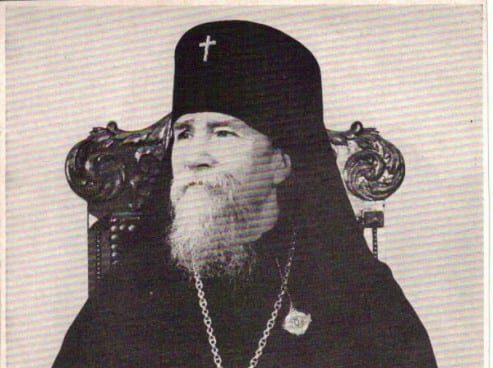
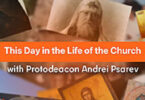







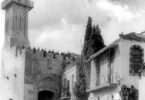

A beautiful tribute to a heroic man. Thank you for sharing.